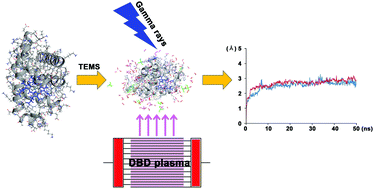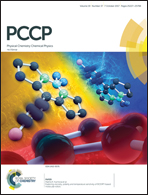Impact of an ionic liquid on protein thermodynamics in the presence of cold atmospheric plasma and gamma rays†
Abstract
Cold atmospheric plasma and gamma rays are known to have anticancer properties, even though their specific mechanisms and roles as co-solvents during their action are still not clearly understood. Despite the use of gamma rays in cancer therapy, they have oncogenic potential, whereas this has not been observed for plasma treatment (to date). To gain a better understanding, we studied the action of dielectric barrier discharge (DBD) plasma and gamma rays on the myoglobin protein. We analyzed the secondary structure and thermodynamic properties of myoglobin after both treatments. In addition, in the last few years, ammonium ionic liquids (ILs) have revealed their important role in protein folding as co-solvents. In this work, we treated the protein with ammonium ILs such as triethylammonium methanesulfonate (TEMS) and tetrabutylammonium methanesulfonate (TBMS) and later treated this IL–protein solution with DBD plasma and gamma rays. In this study, we show the chemical and thermal denaturation of the protein after plasma and gamma treatments in the presence and absence of ILs using circular dichroism (CD) and UV-vis spectroscopy. Furthermore, we also show the influence of plasma and gamma rays on the secondary structure of myoglobin in the absence and presence of ILs or ILs + urea using CD. Finally, molecular dynamic simulations were conducted to gain deeper insight into how the ILs behave to protect the protein against the hydrogen peroxide generated by the DBD plasma and gamma rays.

- This article is part of the themed collection: 2017 PCCP HOT Articles


 Please wait while we load your content...
Please wait while we load your content...